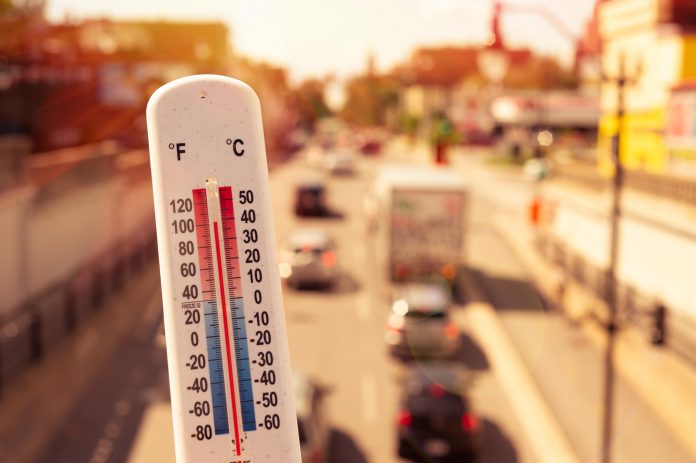As extreme weather events become more frequent, technology can play a key role in protecting the UK’s vital infrastructure, says Marko Ravnjak, applications engineer, monitoring, track survey and scanning at Trimble
This year the UK experienced its hottest summer on record. Unfortunately, it will probably not be the hottest summer of this century. Since climate change is increasing the frequency of extreme weather events, policymakers and climate scientists expect more frequent and intense heatwaves in the years ahead.
Some models have estimated that the UK can expect one heatwave yearly by 2100. Extreme weather events aren’t limited to heatwaves, with flooding being an obvious example – some models currently suggest that southern England could face a 36% rise in the intensity of summer downpours.
Reports have described the UK’s critical national infrastructure (CNI) as being deeply vulnerable to the effects of climate change. With this year’s heatwave bringing about railway shutdowns, a near-blackout in London and road closures, resilience in the face of extreme weather has shot up the agenda for policymakers and infrastructure owners.
Thankfully, this all means that awareness, political will and funding are there to harden the country’s vital infrastructure. The challenge facing stakeholders lies in addressing the most pressing infrastructure vulnerabilities first, getting the highest resilience return on resources and ensuring new infrastructure is fit for the future. Thankfully, technological solutions are helping the industry with just that.
Better planning for new structures
For new structures, major technology that boost resilience to extreme weather are feasibility and predictive tools. After mixing historic data on the site with average costs and environmental impact estimates, feasibility tools can propose hundreds of options for routes and structural permutations. These can offer planners, owners and contractors a range of options to help them enable optimal resilience and cost-effectiveness for structures such as roads, rail tracks, tunnels and bridges.
To achieve this, feasibility tools bring together information on landscape and geography – such as altitude data, water drainage and geology – with data on expected usage, cost and ecological impact. From the outset, this allows infrastructure owners to know the limits of their infrastructure, how much it costs and its net impact on environmental metrics like greenhouse gas emissions.
By mixing in historical weather data to the mix, feasibility systems can help teams avoid areas of high risk. This can allow teams to avoid locations or routes prone to flooding or reinforce new infrastructure in areas that trap heat.
With this, modern feasibility tools can rapidly optimise infrastructure configurations to reflect environmental conditions. At the same time, they can also suggest ways of planning and designing vital infrastructure that’s less vulnerable to environmental risk. For example, a new stretch of road can be rapidly mapped to minimise its flooding risk. Alternatively, rail can be mapped onto routes that are less vulnerable to temperature highs during heat waves.
Monitoring systems for existing structures
Feasibility projections as to how a renovated structure will perform in extreme environmental conditions can help in selecting materials, layout and details of a retrofit. However, these tools cannot help stakeholders select which structures are a priority and develop schedules for predictive maintenance and minimally disruptive retrofits.
It’s here that monitoring capabilities are essential. The internet of things (IoT) and analytics revolution have made real-time structural performance monitoring more accessible than ever. By logging the real-time performance of infrastructure assets in regular and extreme weather conditions, monitoring systems can project the structures most prone to failure during extreme weather events.
This is a tremendous boon for safety and preventing accidents or calamities. By combining real-time and historic data, owners and contractors can be alerted once conditions exceed a structure’s tolerances. This can allow reductions in usage and emergency maintenance work to prevent failure.
The range of variables tracked by monitoring solutions is extensive, sourced from both geospatial data and on-site geotechnical sensors. Because of this, monitoring solutions can combine historical data with current data to offer a comprehensive analysis and visualisation capability, alongside notifications and reports.
Monitoring data can also be used to inform decision-makers what structures represent the best retrofitting return on investment. With figures on the cost of materials and labour also available, infrastructure renovations can be properly budgeted for. This also applies to predictive maintenance schedules, allowing owners to make the best use of their employees’ time and resources.
Leveraging data across the lifecycle
Amid a century of extreme weather, effectively planning and retrofitting structures for resilience requires comprehensive and accurate modelling. To achieve that, the coming years will see the UK’s vital infrastructure accelerate the rapid collection and use of data.
As we’ve seen, the use of this data via feasibility tools and monitoring systems represents a crucial way to harden our vital infrastructure. Through better anticipating and adapting to environmental conditions, these capabilities allow us to optimise our infrastructure to be more resilient, cost-effective and sustainable.
Marko Ravnjack
Applications engineer, monitoring, track survey and scanning
Trimble
Tel: +49 228 60883000

















